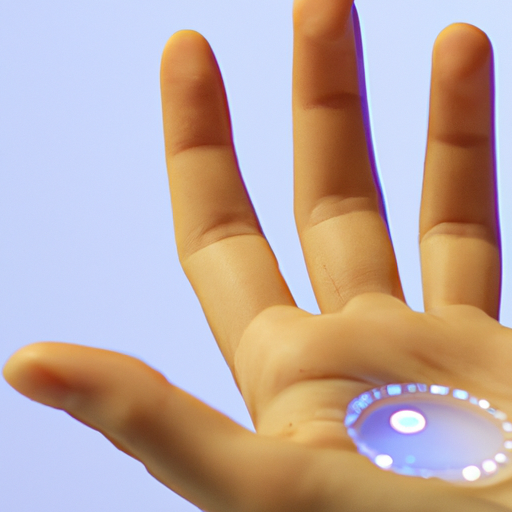Have you ever wondered how touchless motion sensors work? It’s fascinating how these devices can detect your movements without actually being touched. In this article, we’ll explore the science behind touchless motion sensors and uncover the secrets behind their functionality. From infrared technology to ultrasonic waves, you’ll discover the innovative methods employed by these sensors to accurately detect motion and provide a seamless user experience. Whether you’re curious about the technology behind touchless faucets, automatic doors, or motion-activated lights, this article will unravel the mysteries behind these convenient and efficient devices. So, let’s dive in and uncover the science behind how touchless motion sensors work!

Infrared Technology
How Does Infrared Technology Work?
Infrared technology is a widely used method for detecting motion and presence in various applications. It operates by utilizing infrared (IR) light, which is invisible to the human eye but can be detected by specialized sensors. Infrared technology works based on the principle that all objects with a temperature above absolute zero emit some amount of thermal energy, including infrared radiation.
When it comes to touchless motion sensors, infrared technology commonly employs passive infrared (PIR) sensors or active infrared sensors. PIR sensors work by detecting changes in infrared radiation within their field of view caused by the movement of objects. On the other hand, active infrared sensors emit their own infrared light and measure the reflection to detect motion.
Components of Infrared Sensors
Infrared sensors consist of several key components that enable them to function effectively. These components include:
IR Emitters: These components emit infrared light waves, which can be either continuous or pulsed. The emitted light is then reflected off objects in the sensor’s field of view.
IR Detectors: The detectors in infrared sensors are responsible for receiving and measuring the intensity of the reflected infrared light. They can be designed to detect specific wavelengths of infrared radiation.
Signal Processing Units: Once the IR detectors receive the reflected light, the signal processing units analyze the data and determine if motion or the presence of an object has been detected. These units are often equipped with advanced algorithms to filter out potential false positives and provide accurate results.
Output Devices: Infrared sensors are typically equipped with output devices, such as alarms, indicators, or actuators, to alert or trigger a response based on the motion detection.
By combining these components, infrared technology enables touchless motion sensors to accurately detect and respond to movement within their range.
Ultrasonic Technology
How Does Ultrasonic Technology Work?
Ultrasonic technology is another common method used in touchless motion sensors. It operates by emitting high-frequency sound waves and measuring the reflections to detect the presence or movement of objects. Ultrasonic sensors typically operate at frequencies above the range of human hearing, typically in the range of 20 kilohertz (kHz) to several gigahertz (GHz).
To understand how ultrasonic technology works, imagine a bat navigating through the dark using echolocation. The bat emits ultrasonic sound waves, which bounce off objects in its path, and the bat can detect the reflections to build a mental map of its surroundings.
In a similar manner, ultrasonic sensors emit ultrasonic waves, which travel through the air and bounce off objects. The sensor detects the reflections of these waves and measures the time it takes for the waves to return. By analyzing the time of flight and intensity of the reflected waves, the sensor can determine if there is any object or motion in its vicinity.
Working Principle of Ultrasonic Sensors
Ultrasonic sensors consist of the following essential components:
Transmitter: This component emits ultrasonic waves into the environment.
Receiver: The receiver detects the ultrasonic waves that are reflected back by the objects in the sensor’s range.
Time Measurement Circuit: This circuit measures the time it takes for the ultrasonic waves to travel from the transmitter to the object and back to the receiver.
Signal Processing Units: Similar to infrared sensors, ultrasonic sensors employ signal processing units to analyze the data received from the receiver and determine if motion or the presence of an object has occurred.
Ultrasonic technology provides several advantages, including its ability to detect objects regardless of their color, transparency, or surface texture. However, it may be affected by environmental factors such as temperature, humidity, and air turbulence, which can influence the speed and direction of sound waves.
Microwave Technology
How Does Microwave Technology Work?
Microwave technology is another prevalent method used in touchless motion sensors. It operates by emitting microwave signals and detecting the changes in the reflected signals caused by moving objects. Microwave sensors work on the principle of Doppler effect, which refers to the change in frequency of a wave due to the motion of the source or the observer.
Microwaves are electromagnetic waves with longer wavelengths and lower frequencies than visible light. When microwave signals are emitted, they bounce off objects and return to the sensor. The sensor then analyzes the changes in frequency and amplitude of the reflected waves to detect any motion or presence in its range.
Working Principle of Microwave Sensors
Microwave sensors commonly consist of the following components:
Microwave Transmitter: This component generates microwave signals and emits them into the surroundings.
Microwave Receiver: The receiver detects the reflected microwave signals and measures their frequency and amplitude.
Signal Processing Units: Similar to other types of sensors, microwave sensors employ signal processing units to analyze the received data, determine the presence or motion of objects, and minimize false positives.
Microwave technology offers several advantages, including its ability to detect motion through walls and other barriers. However, it can be more susceptible to interference from other microwave sources or objects, which may cause false readings.
Passive Infrared (PIR) Technology
How Does PIR Technology Work?
Passive infrared (PIR) technology is a subset of infrared technology commonly used in touchless motion sensors. PIR sensors work by detecting the changes in infrared radiation emitted by objects in their field of view, rather than emitting their own infrared light.
PIR sensors consist of several key components that allow them to function effectively:
Pyroelectric Sensor: This sensor is the heart of PIR technology. It consists of materials, such as crystals or ceramics, that generate a voltage when exposed to changes in temperature. The sensor detects the infrared radiation emitted by objects, and any change in the received radiation will result in a voltage fluctuation.
Fresnel Lens: The Fresnel lens is responsible for focusing the infrared radiation onto the pyroelectric sensor. It helps improve the sensor’s sensitivity and accuracy by ensuring that the radiation from different areas within its field of view is properly detected.
How PIR Sensors Detect Motion
PIR sensors rely on the principle that when an object moves within their field of view, it causes a change in the distribution of infrared radiation. This change is detected by the pyroelectric sensor, which generates a signal that is then analyzed by the signal processing units.
To minimize false positives, PIR sensors are often equipped with specialized algorithms that filter out certain types of movements, such as those caused by small pets, while still detecting human-sized motions effectively.
PIR technology is commonly used in applications where low power consumption and cost-effectiveness are crucial factors, such as security systems, automatic lighting, and occupancy detection.

Time-of-Flight (ToF) Technology
How Does Time-of-Flight Technology Work?
Time-of-flight (ToF) technology is a relatively new and promising method used in touchless motion sensors. It operates by measuring the time it takes for a light signal to travel from the sensor to the object and back, enabling accurate distance measurement and motion detection.
ToF sensors emit short pulses of light, usually in the form of laser or infrared signals, and measure the time it takes for the light to return to the sensor. By determining the time of flight, which corresponds to the distance traveled by the light, the sensor can calculate the object’s position and movement in real-time.
Working of ToF Sensors
ToF sensors typically consist of the following components:
Light Source: This component emits the light signal, which can be generated by lasers, light-emitting diodes (LEDs), or other light sources.
Photodetector: The photodetector receives the reflected light and measures its intensity or time of flight.
Time Measurement Unit: This unit measures the time it takes for the light signal to reach the object and return to the sensor. This measurement allows the sensor to calculate the distance and motion accurately.
ToF technology offers several advantages, including its high accuracy, fast response time, and ability to operate in various lighting conditions. It is commonly used in applications such as object tracking, robotics, gesture recognition, and augmented reality.
Capabilities and Limitations
Range and Detection Angle
The range and detection angle of touchless motion sensors play a crucial role in their effectiveness and applicability in different situations. These factors determine how far the sensor can detect objects and the extent of its field of view.
The range of a touchless motion sensor depends on various factors, including the technology used and the specific design of the sensor. Some sensors, such as infrared or ultrasound-based sensors, may have a limited range of a few meters, while others, like microwave or ToF sensors, can detect objects at greater distances.
Similarly, the detection angle refers to the width of the sensor’s field of view. Some sensors have a narrow angle, making them suitable for focused detection in specific areas, while others have a wider angle, enabling them to cover larger spaces.
Understanding the range and detection angle of touchless motion sensors is essential when selecting the appropriate sensor for a particular application.
Interference and False Positives
Interference and false positives can be significant challenges when it comes to touchless motion sensors. Interference occurs when external factors or other sensors using similar technologies disrupt the sensor’s operation, leading to inaccurate readings.
For instance, in microwave sensors, interference can be caused by other nearby microwave sources or objects that reflect or absorb the microwaves. Similarly, environmental conditions, such as temperature variations or air currents, can affect the accuracy of infrared and ultrasonic sensors.
To mitigate interference and false positives, manufacturers employ advanced signal processing algorithms, such as adaptive filtering or machine learning, to distinguish between genuine motion and noise. These algorithms analyze the sensor’s data, filter out irrelevant signals, and enhance the detection accuracy.
Reflective Surfaces and Obstructions
The reflective properties of surfaces and the presence of obstructions can affect the performance of touchless motion sensors. Certain materials, like glass or shiny surfaces, may reflect or absorb infrared or microwave signals, making it difficult for the sensor to detect objects beyond these surfaces.
Additionally, obstructions such as walls, partitions, or furniture can block or weaken the transmitted signals, reducing the sensor’s range and accuracy. Therefore, it is essential to consider the environment and the surfaces in which the sensors will be installed to ensure optimal performance.
Some sensors address these challenges by employing multiple detection technologies or adaptive algorithms that can compensate for reflective surfaces and overcome obstructions. These advancements enhance the reliability and functionality of touchless motion sensors in various scenarios.

Applications in Various Industries
Security and Surveillance
Touchless motion sensors find extensive use in security and surveillance systems. They enable the detection and monitoring of unauthorized movement in restricted areas, triggering alarms or alerts when suspicious activity is detected. Whether it’s detecting intruders, alarming about potential break-ins, or ensuring the safety of valuable assets, touchless motion sensors contribute significantly to improving security measures.
Automatic Doors and Access Control
In places with high foot traffic, such as shopping centers, hospitals, or airports, touchless motion sensors play a vital role in automatic door systems. By detecting a person’s presence or movement, the sensors trigger the doors to open, providing a contactless and convenient entry experience. These sensors are also integral to access control systems, allowing authorized individuals to pass through doors or gates using motion-based identification.
Smart Lighting and Energy Management
Touchless motion sensors are widely used in smart lighting systems to enable automatic switching on and off of lights based on occupancy. They help conserve energy by ensuring that lights are only illuminated when needed. Whether in public spaces, offices, or homes, touchless motion sensors contribute to creating efficient and sustainable lighting solutions.
Healthcare and Medical Devices
In healthcare settings, touchless motion sensors have various applications. They are used in occupancy detection for managing room lighting and temperature control in hospitals or clinics. These sensors can also be integrated into medical devices, such as touchless faucets or soap dispensers, reducing the risk of cross-contamination and enhancing hygiene practices.
Automotive Industry
The automotive industry extensively incorporates touchless motion sensors in vehicles for various purposes. They enable hands-free access to trunks or doors, provide motion-based controls for entertainment systems, or contribute to driver assistance features such as parking assist or collision avoidance systems. Touchless motion sensors enhance convenience, safety, and overall user experience in modern vehicles.
Consumer Electronics and Home Automation
Touchless motion sensors have found their place in consumer electronics and home automation as well. They are used in devices like smartphones, tablets, gaming consoles, or virtual assistants, enabling gesture-based control or unlocking features. In home automation, touchless motion sensors contribute to energy-efficient lighting systems, smart thermostats, or security systems, providing convenience, comfort, and peace of mind to homeowners.
The wide range of applications across different industries highlights the versatility and significance of touchless motion sensors in numerous aspects of modern life.
Advancements in Touchless Motion Sensors
Miniaturization and Integration
One significant advancement in touchless motion sensors is the miniaturization of their components. Advancements in microelectronics and manufacturing techniques have made it possible to produce smaller and more compact sensors without compromising their performance. Miniaturization enables the integration of touchless motion sensors into various devices and systems, even in limited space environments.
Improved Sensing Algorithms and Signal Processing
Advancements in sensing algorithms and signal processing have contributed to enhanced performance and accuracy of touchless motion sensors. Manufacturers are continuously developing and refining algorithms that can effectively filter out noise, distinguish true motion from false positives, and adapt to changing environmental conditions. Signal processing capabilities have also improved, allowing for real-time analysis and decision-making based on the sensor’s input.
Wireless and IoT Connectivity
Touchless motion sensors are increasingly incorporating wireless connectivity options, allowing them to communicate with other devices or systems. By utilizing technologies like Wi-Fi, Bluetooth, or Zigbee, sensors can seamlessly connect to smart home systems, security networks, or online platforms. This connectivity enables users to remotely monitor and control the sensors, access data, and integrate them into broader IoT (Internet of Things) ecosystems.
Artificial Intelligence and Machine Learning
The integration of artificial intelligence (AI) and machine learning (ML) techniques has revolutionized touchless motion sensors. AI algorithms are capable of learning from large data sets and extracting valuable insights, enabling sensors to become more intelligent and adaptive over time. Machine learning algorithms can improve detection accuracy, recognize patterns, and even predict user behavior, enhancing the overall performance and user experience of touchless motion sensors.
These advancements in touchless motion sensor technology open up new possibilities for diverse applications and pave the way for even more innovative and intelligent systems in the future.

Future Prospects and Challenges
Emerging Technologies and Innovations
As technology continues to progress, touchless motion sensors are likely to benefit from emerging technologies and innovations. Advancements in materials, such as flexible or printable electronics, may enable the development of sensor systems with unconventional form factors or enhanced durability. New sensing principles, such as terahertz or quantum sensing, might offer even greater precision and capabilities in detecting motion or presence.
Privacy and Ethical Considerations
As touchless motion sensors become more prevalent in various environments, privacy and ethical considerations become increasingly important. Striking a balance between personal privacy and the benefits provided by these sensors is crucial. Manufacturers and policymakers need to address concerns related to data collection, storage, and potential misuse of sensitive information.
Integration with Other Sensors and Systems
Touchless motion sensors can be further enhanced by integrating them with other types of sensors or systems. Combining touchless motion sensors with environmental sensors, for instance, could enable more context-aware or energy-efficient deployments. Integration with artificial intelligence platforms, robotics, or virtual reality systems may open up new avenues for creative and immersive applications.
Cost and Accessibility
While touchless motion sensors have become more affordable over time, cost can still be a limiting factor, particularly for large-scale installations or resource-constrained applications. As technology matures and economies of scale come into play, the cost of touchless motion sensors is expected to decrease, making them more accessible for a wider range of industries and users.
Conclusion
Touchless motion sensors, powered by various technologies such as infrared, ultrasonic, microwave, PIR, and ToF, have revolutionized the way we interact with our surroundings. They enable seamless and contactless motion detection, finding applications in areas like security, automation, healthcare, automotive, and consumer electronics.
Understanding the principles behind touchless motion sensors, their components, and capabilities is crucial for selecting the right sensor for specific applications. Advancements in miniaturization, signal processing, wireless connectivity, and AI-based algorithms have propelled touchless motion sensors into new realms of functionality and performance.
Looking ahead, these sensors stand to benefit from emerging technologies, challenge ethical considerations about privacy, and foster integration with other sensor systems. With ongoing innovations and increased accessibility, touchless motion sensors are poised to continue transforming industries and paving the way for more intuitive and interactive environments.

